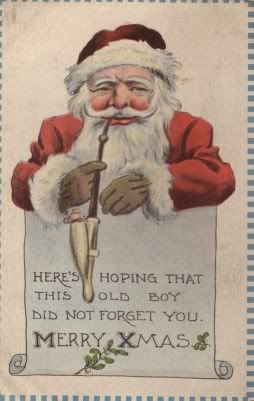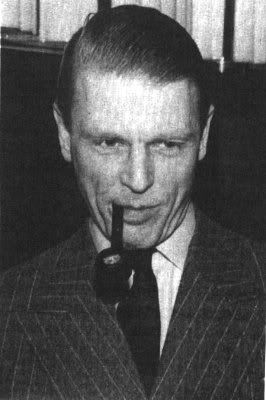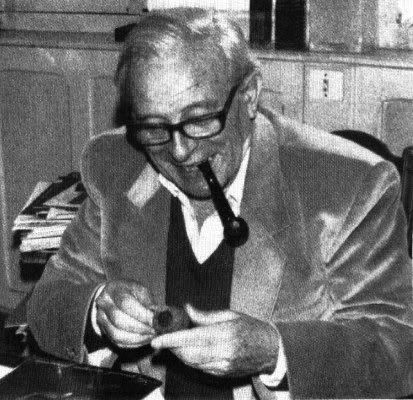
We've seen him before, but this is my annual Christmas Day post.
A blog about pipes and pipe smoking.
Among the sages who Emerson sought out on his visit to Europe was the notoriously reticent and difficult Thomas Carlyle. He called on Carlyle one evening and was given a pipe, while the host took one himself. They sat together smoking in perfect silence until bedtime, and on parting shook hands most cordially, congratulating each other on the fruitful time they had enjoyed together.
 Kūkaku Shiba is a character from the anime series Bleach. She is a former Soul Reaper who has gone renegade from the ranks of the Soul Reapers and lives with her brother Ganju in an outlying district of the Soul Society (the place where departed souls go after death). She is a very powerful spirit being with an expertise in fireworks and when left alone enjoys smoking her pipe, which is of the old Japanese kiseru design. She always appears with what seems to bandages around her head, right shoulder and ankles, and if you look closely you can see that her right arm is prosthetic.
Kūkaku Shiba is a character from the anime series Bleach. She is a former Soul Reaper who has gone renegade from the ranks of the Soul Reapers and lives with her brother Ganju in an outlying district of the Soul Society (the place where departed souls go after death). She is a very powerful spirit being with an expertise in fireworks and when left alone enjoys smoking her pipe, which is of the old Japanese kiseru design. She always appears with what seems to bandages around her head, right shoulder and ankles, and if you look closely you can see that her right arm is prosthetic. She has a very elegant way of holding her pipe which keeps her fingers away from what is most likely a very hot bowl.
She has a very elegant way of holding her pipe which keeps her fingers away from what is most likely a very hot bowl. Her brother Ganju had previously encountered Ichigo Kurosaki (the main protagonist of the series). Kūkaku's and Ganju's brother, who had also been a Soul Reaper, had been killed by another Soul Reaper, which was one thing that led to Kūkaku's departure from the Soul Reaper ranks. As a result of her brother's death, both she and Ganju have great animosity for other Soul Reapers, of which Ichigo is one. He and Ganju begin fighting, which she tolerates as she placidly smokes her pipe.
Her brother Ganju had previously encountered Ichigo Kurosaki (the main protagonist of the series). Kūkaku's and Ganju's brother, who had also been a Soul Reaper, had been killed by another Soul Reaper, which was one thing that led to Kūkaku's departure from the Soul Reaper ranks. As a result of her brother's death, both she and Ganju have great animosity for other Soul Reapers, of which Ichigo is one. He and Ganju begin fighting, which she tolerates as she placidly smokes her pipe. Until one of them knocks it from her fingers during the fight.
Until one of them knocks it from her fingers during the fight. At this, she becomes somewhat agitated.
At this, she becomes somewhat agitated. Soon after, in their ongoing struggle, Ichigo steps on...
Soon after, in their ongoing struggle, Ichigo steps on... ...and shatters her pipe.
...and shatters her pipe. At which point she becomes quite perturbed.
At which point she becomes quite perturbed. And things tend to...
And things tend to... ...escalate...
...escalate... ...from there.
...from there.



Jacques Faizant was one of France's most popular press illustrators. After studying at the hotel school in Nice, he worked in several hotels until 1938. He settled in Marseille and went to work as an illustrator. During the War, he drew for Le Dimanche Illustré and La Revue de l'Écran, while also composings songs and cooperating with Lortac on animation projects. Upon the Liberation, he headed for Paris and started out working for Carrefour and L'Ecran Français. He was eventually assigned by Jean Nohain of Bonjour Dimanche and its supplement Le Petit Canard. For this supplement, Faizant made comics like 'Le Colonel Broum et Patapoum', 'Pyk et Pato au Centre de la Terre', 'Monsieur Mite' and 'L'Invraisemblable M. Pluche'.
He also made several strips for the daily press, of which 'Adam et Eve' was the longest running (approx. 700 or 800 gags). This family comic debuted in France Dimanche in 1949, and was renamed 'Adam et Eve (et Caïn)' when the characters got their first child. In addition, Faizant made independent strips, as well as 'Le Tour en Dessins' in La Dépêche (1948), 'Les Aventures de M. Faribole' and 'Docteur Doublevé' in Le Parisien Libéré, 'Bouts (de crayons) Rimés' in Ici-Paris and 'M. Patraque' in La Vie Catholique. He also made the advertising strip 'Le Chimiste BP', that was published between 1954 and 1957 in Le Midi Libre, L'Union, La Dépêche and Le Main Libre.
From 1960, Faizant worked as a political cartoonist for Le Figaro, while also continuing to work as a humorous illustrator in Le Chasseur Français, La Vie du Rail, Détective, Rires Magazine and jardin des Modes until the 1990s.
 Click to enlarge and you can read all the fine print. Probably from the 50s. I used to try filtered pipes when I was a pipe-n00b, and I didn't like them. I note one completely bogus claim in this ad: "Cushion Bite Nylon Bit Guaranteed Bite Proof." I've seen many, many nylon bits chewed completely to h***. The most bite-proof stem is the hard acrylic, from my experience. Using a nylon stem is like smoking a drinking straw.
Click to enlarge and you can read all the fine print. Probably from the 50s. I used to try filtered pipes when I was a pipe-n00b, and I didn't like them. I note one completely bogus claim in this ad: "Cushion Bite Nylon Bit Guaranteed Bite Proof." I've seen many, many nylon bits chewed completely to h***. The most bite-proof stem is the hard acrylic, from my experience. Using a nylon stem is like smoking a drinking straw.

Kiseru is an old style Japanese smoking pipe. Kiseru have been used for smoking a very fine, shredded tobacco, as well as cannabis. It is typically made out of metal on the ends (the mouth piece and bowl), with a shaft typically made out of bamboo. Another distinct trait of a kiseru is that the bowl is much smaller than that of many western-style pipes, and if fitted with a fine-mesh metal screen, permits small servings of any sifted herb at a low burning temperature.Click the link for more details and history.